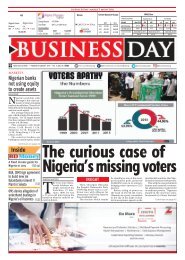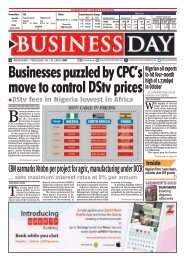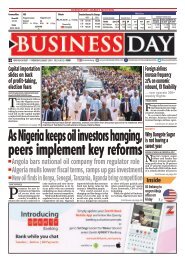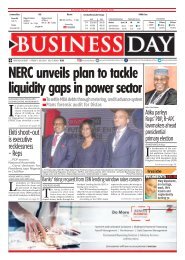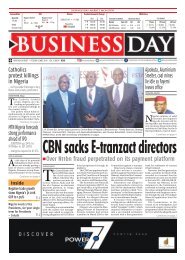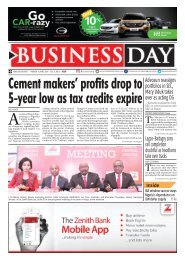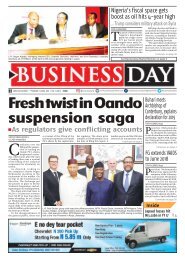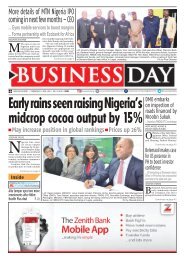BusinessDay 22 Jun 2017
You also want an ePaper? Increase the reach of your titles
YUMPU automatically turns print PDFs into web optimized ePapers that Google loves.
Thursday <strong>22</strong> <strong>Jun</strong>e <strong>2017</strong><br />
COMMENT<br />
STEVE NKWOR MIRM (UK)<br />
Steve Nkwor a risk management consultant<br />
and writes from Lagos, Nigeria. He<br />
can be reached on snkwor@snaconsulting.org<br />
There are first steps in<br />
ERM implementation.<br />
To begin with, appropriate<br />
Tone-at-the-<br />
Top needs to be set.<br />
We already considered this in the<br />
immediate past article. Following<br />
from that, a sponsor of the project<br />
would need to come on-board to<br />
steer the ship. This overall leader<br />
of the project is what we are considering<br />
in this article. He or she<br />
may need to appoint a consultant.<br />
A roadmap, with clear milestones,<br />
should also be produced and a<br />
project team constituted.<br />
There are those that opine<br />
that implementing ERM, with a<br />
project plan as outlined above,<br />
prolongs its go-live and therefore<br />
a waste of resources. To such<br />
minds, it would suffice to just create<br />
the ERM function, designate a<br />
head and then kick-start it.<br />
Should ERM implementation<br />
strictly then be approach<br />
as a project? Is there a need to<br />
designate a Sponsor? Would it<br />
be a duplication of roles to have<br />
ERM: Project Sponsor<br />
a project manager and a project<br />
sponsor? What key results should<br />
the ERM project sponsor deliver?<br />
These are pertinent questions we<br />
will endeavour to address in this<br />
article.<br />
A simple definition of a project<br />
is that it is a set of interrelated<br />
tasks to be executed over a fixed<br />
period and within certain cost<br />
and other limitations. Strictly<br />
speaking, every ERM implementation<br />
involves the design<br />
and deployment of interrelated<br />
framework components. ERM<br />
projects, irrespective of scale,<br />
have milestones that are to be delivered<br />
within budget. This makes<br />
it fit more aptly into this definition.<br />
Constituting a project to design<br />
and deploy ERM framework<br />
remains one very practical way to<br />
train and kick-start the function.<br />
All these are best achieved within<br />
the leadership of an executive<br />
sponsorship of the project.<br />
A topic like this becomes very<br />
important because the term<br />
‘project sponsor’ is too often<br />
misconstrued to mean a moneybag<br />
whose main responsibility is<br />
to secure the project funds and<br />
then show up at the commissioning<br />
stage for a thumbs-up. This is<br />
a destination syndrome. It is not<br />
the picture of an ERM sponsor.<br />
ERM projects are implemented<br />
to activate a cycle - the risk management<br />
cycle - and not to hit a<br />
destination. All the well known<br />
Strictly speaking, every<br />
ERM implementation<br />
involves the design and<br />
deployment of interrelated<br />
framework components.<br />
ERM projects,<br />
irrespective of scale, have<br />
milestones that are to be<br />
delivered within budget<br />
risk management standards endorse<br />
the risk management process<br />
as a cycle. This makes ERM a going<br />
concern journey. Irrespective of<br />
whether an organisation is forprofit<br />
or not-for-profit, the picture<br />
of an ERM sponsor is one that is<br />
meant to champion the design and<br />
deployment of a framework and to<br />
deliver on the initial risk reports. An<br />
ERM sponsor is therefore one that<br />
sits on the project to walk-the-talk<br />
of management buy-in. He/she<br />
brings the sail or sink drive to the<br />
project and this often makes the<br />
difference between success and<br />
failure.<br />
The project sponsor and the project<br />
manager will, under preferred<br />
arrangements, be working closely<br />
from start to finish. ERM projects<br />
should begin with milestones that<br />
are approved by the management<br />
or board. This outlines project<br />
deliverables and the turn-around<br />
C002D5556<br />
comment is free<br />
Send 800word comments to comment@businessdayonline.<br />
deadlines. The project manager’s<br />
responsibility is to make the dayto-day<br />
calls on the project. While<br />
the sponsor authorises the project,<br />
the project manager executes it. It<br />
is the responsibility, therefore, of<br />
the sponsor to provide clear leadership,<br />
secure project resources,<br />
ensure project is on time and on<br />
budget, engaging the necessary<br />
stakeholders and championing of<br />
the project at the executive level to<br />
secure continued buy-in.<br />
To address the question: ‘what<br />
key results should the ERM project<br />
sponsor deliver?’ The sponsor<br />
should, in the first place, deliver a<br />
common language for risk communication<br />
in the organisation. It<br />
should also deliver the integration<br />
of strategy, risk management and<br />
the decision making processes<br />
of the organisation. The sponsor<br />
should, in addition, deliver<br />
a process that cascades the organisation’s<br />
risk appetite through<br />
to core processes’ tasks. It is also<br />
part of the sponsor’s call to deliver<br />
a clear structure of risk defence<br />
system that put risk ownership,<br />
risk control and risk audit functions<br />
in clear perspectives.<br />
Risk identification is very central<br />
in an organisation’s risk management<br />
process and the project<br />
sponsor should deliver a model.<br />
In order for the organisation to<br />
properly manage solvency or economic<br />
capital, the project sponsor,<br />
should in addition, deliver a<br />
BUSINESS DAY<br />
11<br />
system for own risk and solvency<br />
assessment. This should be a fitto-size<br />
measurement structure<br />
for market, credit and operational<br />
risks. It should also deliver a model<br />
for risk control. Last of all, it should<br />
deliver the desired initial risk<br />
reports.<br />
Overall, organisations that engage<br />
a sponsor in implementing<br />
ERM often utilise and benefit from<br />
project management. They effectively<br />
manage finish-to-start project<br />
dependency. They thus allow<br />
framework design, for instance, to<br />
finish before its deployment starts,<br />
the same way land is acquired before<br />
a building erection can start.<br />
Start-to-start project dependency<br />
is also better managed. Objectives<br />
setting, as a culture for instance,<br />
will be allowed to start before risk<br />
identification will start. This way,<br />
risk will not be identified out of<br />
context. ERM projects do, in addition,<br />
manage finish-to-finish dependency.<br />
This allows risk assessment<br />
to finish before economic or<br />
solvency capital measurements<br />
can finish, for instance. Start-tofinish<br />
project dependency will<br />
equally be well managed. The new<br />
culture that ERM embeds will be<br />
allowed to start before the existing<br />
one can finish or be outlawed.<br />
Send reactions to:<br />
comment@businessdayonline.com<br />
CHIDO NWAKANMA<br />
Vice President YemiOsinbajo<br />
scored a bull’s eye with his<br />
identification of the pathogen<br />
causing the eruption<br />
and inflammation of ethnic animus<br />
across Nigeria recently. Speaking<br />
<strong>Jun</strong>e 14 to Influencers from the South<br />
East, and before them those from the<br />
North,Osinbajo pointed to the failure<br />
of communication.<br />
The Vice President stated: “It is<br />
also clear that wars sometimes start,<br />
not with bullets, but with words.<br />
Hateful, incendiary speech, opening<br />
floodgates of blood. The tongue, like<br />
the pen, is often mightier than the<br />
sword – because it is what pushes the<br />
sword into action. When we throw<br />
words like stones in a marketplace, we<br />
do not know who or what it will hit.”<br />
The issue, of course, is the narrative<br />
around BiafraExit and NigRemain.<br />
Since 2015, public communication<br />
in Nigeria has tended towards the<br />
negative and the extreme. Discussionon<br />
the elections was provocative,<br />
insulting and aimed at drawing blood.<br />
It was par for the course, some said, as<br />
political communication is warfare.<br />
However, the amplification of ethnic<br />
sentiments in our political sphere<br />
dates back to the run up to the 2011<br />
elections after the death of President<br />
Umaru Musa Yaradua.<br />
Unfortunately, it has continued.<br />
President MuhammaduBuhari reduced<br />
the halo of the Presidency with<br />
his emotive comments and conduct<br />
that further polarised the nation. It<br />
was that negative mindset that enabled<br />
the flowering of the New Biafra.<br />
There are many views and arguments<br />
for and against the BiafraExit.<br />
Whatever the case, communication<br />
around the putative republic has been<br />
less than salutary.<br />
Two Hs have characterised the<br />
narrative around the New Biafra. They<br />
How communication failure is heating up Nigeria over Biafra<br />
are hate and hubris. Proponents of<br />
the New Biafra speak with arrogance<br />
about alleged Biafran exceptionalism.<br />
They point to many Igbo firsts,<br />
the progress of the Igbo individually<br />
since the civil war and their ability to<br />
survive in harsh environments like<br />
the cactus as grounds for confidence<br />
in the success of a New Biafra. They<br />
then undermine these positives by diminishing<br />
other ethnicities and even<br />
preaching hatred against the various<br />
groups. The arrogance extends to<br />
claiming territories outside core Igbo<br />
land as parts of the New Biafra and<br />
dismissing the objections of persons<br />
from those areas peremptorily.<br />
War veteran and general, President<br />
MuhammaduBuhari worsened<br />
the situation with the maladroit handling<br />
of a prickly situation. Note that<br />
MaziNnamdiKanu had commenced<br />
his Radio Biafra and its vile outpourings<br />
two years before the ascendancy<br />
of Buhari. There was before that the<br />
Movement for the Actualisation of<br />
the Sovereign State of Biafra since the<br />
Obasanjo government. The Goodluck<br />
Jonathan government watched Kanu<br />
askance, keeping a distance. Buhari<br />
went for the jugular, same as he did<br />
ill-advisedly with the Niger Delta agitators,<br />
and ended up turning a fringe<br />
movement into the mainstream. His<br />
pronouncements on the division of<br />
the spoils of office and actual conduct<br />
in thedeployment of state power<br />
worsened the feeling of alienation.<br />
Negative emotions have driven<br />
the conversation around Biafra. A<br />
conglomeration of youths from the<br />
North raised the decibel of negativism<br />
with their pronouncement on <strong>Jun</strong>e<br />
6, <strong>2017</strong>,asking Igbos to quit Northern<br />
Nigeria. As with the New Biafra, the<br />
tone and tenor of their remarks were<br />
combative and filled with the two Hs<br />
of hate and hubris. They matched and<br />
exceeded Kanu and his Radio Biafra in<br />
the quantum and vehemence of their<br />
invectives and hatred of the Igbo.<br />
Nigeria is now on a knife-edge arising<br />
from wrong policies but more from<br />
the narratives around the traditional<br />
struggle for preferment amongst groups<br />
in a diverse polity.<br />
The explosion of platforms in Media2.0<br />
has worsened the failure of<br />
public communication. The Nigerian<br />
situation today vividly illustrates the<br />
pitfalls and dangers of the new media<br />
order. We have lost the gatekeeping<br />
role prevalent in old media to a free for<br />
all. Opinion formation takes the form<br />
of who shouts the loudest, without<br />
the benefit of peer review and test for<br />
taste, validity, appropriateness, ethics<br />
and fair comment. Gatekeepers in<br />
time past checked for these attributes<br />
to minimise harm.<br />
The era of citizen journalism sees<br />
a deluge of information without communication.<br />
There is so much out there,<br />
from all the ethnicities.<br />
There is a discernible vacuum in<br />
the media space. The era of dominant<br />
media organs to which citizens turned<br />
for direction is gone. There are no such<br />
organs anymore either in the print or<br />
online, leaving a dangerous space now<br />
filled by all manner of platforms. The<br />
result is the current anomie.<br />
Effective communication is purposive<br />
and persuasive. It is planned,<br />
with clear objectives, milestones and<br />
messages. The New Biafra says its<br />
intendment is to cause Nigeria to hold<br />
a referendum to determine whether<br />
persons in the demographic would<br />
want to stay on in the country. Because<br />
the messaging has been diffuse and obtuse,<br />
it has not been persuasive. Rather<br />
it has brought out the beast in the other<br />
rather than winning their empathy and<br />
support.<br />
Messaging by IPOB has been<br />
full of bile and hatred against other<br />
ethnicities. They post false narratives<br />
on various issues, including religion.<br />
The most recent are trending video<br />
and audio messages of attacks on<br />
Igbos in the North or the sighting of<br />
ammunition in vehicles in the East,<br />
all of which are false.<br />
It would seem that rather than<br />
the stated objective, IPOB and the<br />
BiafraExit movement want to force<br />
the motion by deliberate provocation<br />
of other groups, thus putting the lives,<br />
relationships and well-being of its<br />
primary stakeholders at significant<br />
risk all by its actions.<br />
The sole credit of the IPOB campaign<br />
is forcing a renewed discussion<br />
of the structural and other inequities<br />
of the Nigerian federation. Each day,<br />
new revelations indicate the complicity<br />
of the current federal government<br />
in deepening the fissures through outright<br />
disregard for the laws of Nigeria<br />
on Federal Character and the sensibilities<br />
of other groups. But IPOB’s<br />
communication has been deleterious,<br />
particularly so to its primary audience.<br />
Among the functions of communication<br />
that experts identify are<br />
integration, socialisation and mobilisation.<br />
Integration involves providing<br />
to all persons and groups “access<br />
to the variety of messages that they<br />
need to understand each other and<br />
to appreciate others’ living conditions,<br />
viewpoints and aspirations”. The media<br />
contribute to the socialisation process<br />
by providing a “common fund of<br />
knowledge” enabling full functioning<br />
of citizens. The motivation function<br />
involves “the fostering of individual<br />
or community activities, geared to the<br />
pursuit of agreed objectives” (Mac-<br />
Bride, 1980).<br />
The absence of persuasive communication<br />
has hampered integration<br />
in Nigeria particularly in the last two<br />
years. Communication traditionally<br />
would attempt to influence beliefs,<br />
attitudes, motivations and behaviours<br />
of its audience about an idea, object,<br />
or other persons. A grand project such<br />
as the New Biafra requires strategic<br />
communicationto create awareness,<br />
understanding, acceptance in some<br />
cases, or at least empathy for it in others.<br />
Effective communication avoids<br />
distorting messages during the communication<br />
processes. Communication<br />
is effective when it leads to the<br />
sharing of information accurately between<br />
sender and receiver and causes<br />
the desired response. It should generate<br />
and retain the effect you want.<br />
Communication of the New Biafra<br />
also calls for reflection by professionals.<br />
IPOB has triggered the Agenda Setting<br />
function of the media by placing<br />
the matter of an independent country<br />
on the burner of discourse. Agenda setting<br />
theory posits the interplay of forces<br />
in the socio-economic environment,<br />
and this is playing out.<br />
However, agenda setting is not a<br />
theory of persuasion. Diffusion of innovation<br />
is one of the most prominent<br />
theories of strategic communication.<br />
Application of this theory or any theory<br />
or model of persuasion lacks in the<br />
current narratives, for and against the<br />
proposition.<br />
There is a need for better communication<br />
in the public sphere in<br />
Nigeria. The proponents of Biafra need<br />
to deploy strategic communication<br />
and use the principles of persuasion or<br />
social influence enunciated by Robert<br />
Cialdini and the experts in psychology<br />
and communication.<br />
Send reactions to:<br />
comment@businessdayonline.com




